Introduction
The production of rice has greatly increased as it is a staple food and hundreds of people consume it from across the world. Mostly, these are people living below the poverty line struggling to make a living in the developing countries such as South America. The production of rice varies in different parts of the world due to various agroclimatic conditions. Rainfed rice is only common in southern America whereas the majority is grown through irrigation in the USA (Surendran, 2021). However, irrigation water is becoming a very scarce resource since the production of rice requires a lot of water. Moreover, soil quality and water pollution have become contributing factors to the amount of rice that is being produced. Rice commercialization is very crucial as it helps in reducing hunger and poverty among poor people. This is after there has been a rise in population growth all over the world. Therefore, rice production is expected to rise by 25% in the next 25years as a result of the rising rate of population (Fahad, 2019). Nevertheless, the worldwide production of rice contributes to severe environmental impacts, endangering sustainability. Mass production of rice releases harmful greenhouse gases into the environment and consumes a huge amount of water thus affecting productivity which has started to decrease.
Effect of Rice Production on the Environment
Even if rice is one of the major staple foods all around the world, it highly contributes to global warming. This is through the huge amount of water that is used during irrigation. Excess use of water encourages methane production since rice grows in flooded fields commonly known as rice paddies. A lot of water prevents oxygen from entering the soil thus creating a conducive environment for bacteria that produce methane to grow. The more the flooding persists the more the bacteria build-up thus producing a lot of methane which is very harmful to the environment. Methane is 100 times more harmful to the environment than any other gas such as carbon dioxide (Hutchins et al., 2019). This is because it leads to the formation of the ground-level ozone layer which is very dangerous and that have caused millions of premature deaths all over the world. Moreover, burning the residues from rice production such as husks and straws also contributes to the emission of greenhouse gases. Nitrous oxide, a harmful potent greenhouse gas is also released into the atmosphere through the inefficient application of nitrogen fertilizers during planting.
Agrochemicals is a contributing factor to the rise in environmental pollution. It is seen when farmers increase the use of fertilizers to double the production of rice as well as reduce the amount of labor that is required during the process of weeding. However, the excessive consumption of these fertilizers reduces soil microbial biomass that aids in decomposing animals and plants’ residue that later releases carbon dioxide and other harmful gases (Pickson et al., 2022). Nevertheless, the chemicals cause alkalinity or acidity which causes disturbance in the soil ecosystem as it loses its fertility and the ability to produce a lot of otputs. Apart from destroying the water paddies, the chemicals move from the rice irrigation schemes into various water reservoirs, causing contamination of the freshwater systems.
Rice production consumes a lot of water than other plants which is estimated to be 40% of freshwater (Mekonnen et al., 2018). This has led to the depletion of fresh water supplied to other parts of the country. During the mass production of rice, a lot of water is wasted causing flooding which then increases soil sanity and water-logging. This adds up to the negative impacts that it has on the environment which are droughts and water shortages. Once water shortages and drought take lead, the nutritional value of rice is affected as temperatures increases due to global warming.
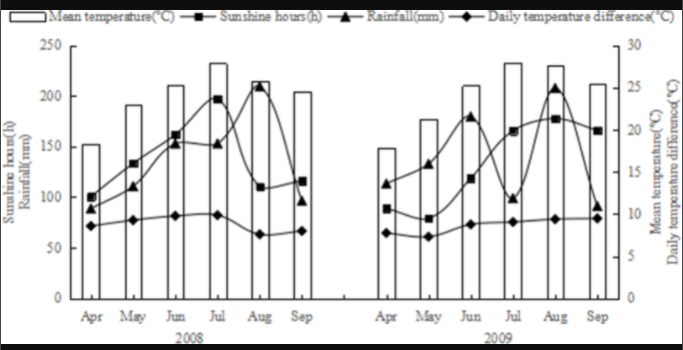
An analysis was performed to evaluate the factors that led to the production of rice as well as the impacts caused. They are shown through the Political Economical Social Technological Environmental Legal analysis which is used to assess the external environment related to the production of rice. They include:
- Political impact
- Economic impact
- Social impact
- Technological impact
- Environmental impact
- Legal impact
Political Impact
Most economies from developing countries depend on the production of rice to sustain their political interest. Even if its production poses a huge threat to the atmosphere, it has increased political interests. This is because the government views the production of rice as a form of food security. Politicians are able to deal with the rising growth in population that needs to be fed to prevent drought. Even if the intensive production of rice does not always bring profitability, it contributes to the rise of global cereal output all over the world. From the days of the green revolution, improved technologies such as the use of agrochemicals and improvised seeds, the production of rice have increased by 100% (Sandhu et al., 2021). During this era, the population from the developing countries has increased rapidly whereas food prices have decreased. This has caused the government to advocate for the production of rice so that it can favor the economy. They have neglected the fact that its production poses a threat to environmental sustainability. This is from the loss of soil fertility, water management, and also emission of harmful gases.
Economic Impact
In the last couple of years, rice consumption has drastically increased as the population increases in developing countries. This is a positive impact on the economy since the production of rice must increase by 30 % so that it can cater to everyone (Jerez, 2019). This brings about food security and economic independence in the countries producing the product. Increased production of rice leads to the demand for labor thus providing employment opportunities to a lot of people. When people are provided with employment, their standard of living rise thus reducing the dependency rate. This is a positive impact on the economy as it will reduce the number of resources that are given to the unemployed. Bangladesh is one of the places that has had success while promoting economic growth and reducing poverty. From 2000 to 2018, poverty rates have decreased from 53% to 24% as production of rice has increased dramatically (Mohajan, 2018). This has been a result of the positive development in the farming sector as there are have been an improvement in seeds and technology. For instance, Vietnam was the fifth largest producer of rice all over the world which resulted in a rice revenue of up to 1.6 billion dollars (Maitah et al., 2020). The figure below clearly shows that Vietnam’s economy depended on the production of rice.
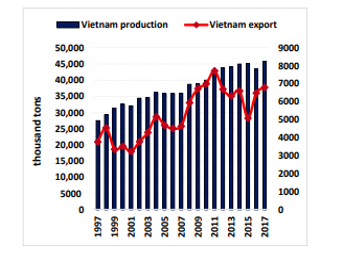
Social impacts
PESTEL analysis considers social impacts that are caused by the production of rice. Social pressures and norms are essential in determining how consumers will behave. In the world today, people have created a norm whereby rice is highly consumed almost in a daily basis. With the rising population growth rates, small scale and large-scale farmers are forced to increase the production to meet the increasing demand. The percentage of the people that consumes rice has increased since 2000 due to the its affordability. Moreover, its rise in production has created a lot of opportunities for the youth, thus reducing poverty and increasing their standard of living.
Technological impacts
Generally, it has been discovered that the production of rice is connected to other limiting factors such as lack of advanced technology which at times causes soil erosion, and terrain. For instance, without an advancement in the technology, a lot of water will be used to produce rice. This is because farmers will use every source of water for the purposes of massive rice production (Schneider & Asch, 2020). However, it is not even possible to produce a lot of rice without consuming a lot of water. This is the main reason why conserving water gets even harder. Flooding water is not the only option that facilitates the growth of rice but it is the only effective way that averts the spread of the unwanted weed. This method is very essential to a lot of farmers and how they operate as they would find it very hard to produce it in any other possible way. Through flooding paddy fields, the UN food and Agriculture Organization has found out that more than 770 million tons of rice were produced in 2018, with India and China producing more than half (Ferdouse et al., 2018). This was achieved through the use of advanced technology that are used in India and China. To deal with such a problem, there must be an improvement in the field of technology so that conservation of water can be achieved. Farmers should use water sprinklers that enhance minimum wastage of water. They should also use improvised machines that are not heavy to reduce soil compaction.
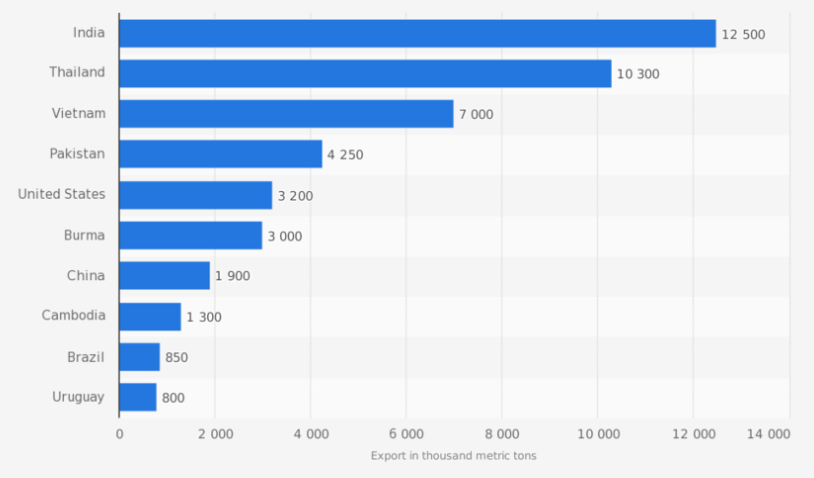
Environmental impacts
Environmental degradation is a procedure in which nature and the surrounding are compromised in various ways, reducing their general health to sustain themselves mostly in the future. Some of these processes can be as a result of natural causes and at times due to human activities such as the use of tractors for farming (Streimikiene et al., 2021). The use of tractors during rice production to cultivate land is one of the leading factors that cause degradation. This is because these advanced technologies cause huge problems to our lands leading to soil erosion. Moreover, driving the heavy tractors on the same soil that grows rice causes compaction caused by reduced air volume, soil density as well as the ability to drain excess water. Therefore, the soil is damaged leading to less crop production. Not only are crops production reduced but also an increase in siltation in rivers and pollution are also heightened. Even if some of the leading producers of rice use these heavy machines to boost their productivity, most of them are a threat to sustainability and the environment as well. Most countries have failed to come up with favorable farming techniques that are more environmentally friendly and can sustain the atmosphere even in the future.
Legal impacts
As discussed earlier, most of the economies all around the world depend on the production of rice. Therefore, as a result of its financial value, the policymakers are authorized and forced to produce more as a way of dealing with production deficits so as to meet the expected demand (Boswell, 2018). This poses a huge risk to the environment as it is not easy to increase production without using enough water, fertilizers, pesticides, and land. In this case, the production of rice means that the number of water reservoirs that are available will be directed to the rice paddies for the purposes of irrigation. This means that the supply of water will decrease drastically in urban areas. Moreover, the emission of methane and nitrous oxide will also be increased causing global warming which also means premature deaths will rise. The demand to increase production and decrease deficits will have hindered environmental sustainability in the long run. The figure below shows the rate at which policy makers are influenced to decrease the deficits when it comes to the production of rice.
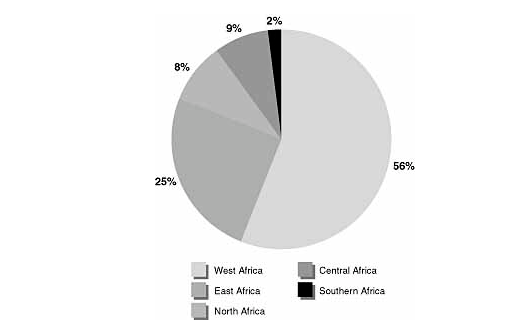
How to Maintain Environmental Sustainability
Using a Sustainable Approach
In order to use a sustainable way of dealing with environmental sustainability, farmers should come up with a sustainable rice farming method (Connor et al., 2022). For instance, farmers should be trained on how to implement alternate wetting & drying and micro-irrigation. Alternate wetting and drying are a practice that is used in irrigation to save water as well as reduce the number of gases that are emitted into the atmosphere while maintaining yields. This practice is simply implemented through the use of a field water tube or commonly known as pani tubes that are used to measure the depth of the water in the farms. After using this method, the depth of water gradually decreases, hence saving a lot of water during irrigation. This is one of the greatest ways of reducing floods and becoming resource-efficient. Alternate Wetting and Drying will not only help in saving water but also in reducing the emission of methane into the atmosphere. Studies have proven that alternate and drying approaches can reduce the consumption of water by 30% and 48% for methane emissions (Runkle et al., 2018). However, for farmers to switch to these sustainable practices, a lot of training must be done so that they can understand the process.
Another way of increasing the sustainability of the environment is through the use of better machines that are precise, efficient, and lean (Siegel et al., 2019). This is done to reduce the negative impact that the current machines have had on the soils such as soil erosion and loss of fertility. This is because some of the machines that are used to plants seeds and apply fertilizers are very heavy. Using lighter machines in the irrigation farms will help in creating a more sustainable environment since the soil will not be damaged. Using sprinklers to produce rice will enhance the saving of water and power. One of the techniques is conservation agriculture which is important in reducing soil tillage as well as pesticides that have a huge effect on the environment. The figure below is a perfect representation of how a sustainable approach can increase the growth of rice in a couple of years.
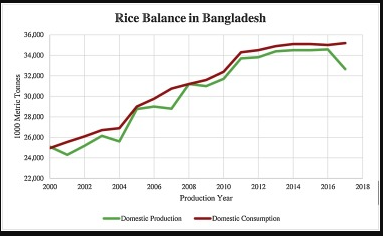
Using Proper Management of Resources
Sustaining the environment must involve the right number of resources to ensure that water and land are used efficiently. This is essential since it ensures there is minimal wastage of any resource that can be used to achieve economically, socially and environmental outcomes in future. For instance, with proper management, the amount of water used during irrigation can be reduced by 50% without having to affect the outputs (Eamen, Brouwer & Razavi, 2020). Since water is the most essential component for sustainable production of rice, proper management should be enforced to reduce wastage. Moreover, due to the rising cases of global warming, fresh water reservoirs are reducing by the day while the use of fertilizers brings additional cost to the farmers.
There are sufficient farm practices that cater for every challenge of rice production. They mostly apply to small farmers with minimum number of resources and inputs. One of the practices that promote sustaining is pre-planting practices whereby farmers are advised to use healthy seeds so that they can get a good number of outputs (Somasundaram, 2021). An efficient pre-plant practice also means that farmers understand every season and that they can provide the labor and inputs that are required. This way, farmers are able to control their resources and even organize their farm to enhance a sustainable environment. Another practice is through growth practices that starts with growth management where crops are planted properly. Even if rice crops can be planted directly and then transported later, choosing the right planting practice depends on the soil type. The location, availability of inputs, rice ecosystem and physical labor also contribute to a better.
Degradation
Some of the methods that have been mentioned above might be a little difficult to implement. This is because farmers always choose a method that brings profitability to them despite the dangers posed to the environment. However, the government can enforce laws to prevent the expansion of rice growth in areas that causes wetland degradation and siltation (Liao et al., 2019). Wetland degradation is caused by human activities through the change of water quality, high rates of pollutant inputs and also water quantity. Water degradation have an adverse effect on the health of human and should be dealt with at all costs. On the other hand, siltation is a form of water pollution that is caused by particulate materials with huge particles dominated by clay or silt. It occurs where the sediments have increasingly accumulated in places that are undesirable. The government can also come up with laws that encourage the investment in advanced technologies that boost yield and reduce irrigation input. Such a strategy can help a country meet all the expected demand as well as benefit farmers and their customers.
Farmers need to come up with a new breed of crops in order to reduce the environmental impact. This is after there have been an increase in the climate change challenges that make it hard for the production of rice in the future. For instance, growing a new breed of seed during the shorter and dry season when there is minimum amount of water can aid in the reduction of greenhouse gases (Hussain et al., 2020). Therefore, farmers need to come up with a variety of seeds for all seasons so that they can keep up with the growing demand and most importantly conserve water. These are some of the sustainable practices that farmers should work with to reduce the climate change effect as well as protect the environment.
Conclusion
Even if people from all over the world use rice as their staple food, its production has an adverse effect on the environment and its sustainability. This shows that there is a lot of work that should be done to improve the farming methods that do not harm the environment and most importantly the soil. A better sustainability of the environment leads to better and consistent yields in the future. This also improves the standards of living as adequate production of rice will improve the farmers income as well as the economy. Using favorable production methods would mostly benefit the developing countries as they will have a sustainable income as well as a source of food. This is essential as it reduces poverty ang hunger in most countries all over the world that are trying to develop. Hence, if the production of rice is able to satisfy the increasing demand, then adapting to sustainable methods will be very essential to help in protecting the environment and mostly the natural resources. Even if it means enforcing harsh rules and laws on all farmers and consumers who are involved in the production of rice.
References
Connor, M., Quilloy, R., de Guia, A. H., & Singleton, G. (2022). Sustainable rice production in Myanmar impacts on food security and livelihood changes. International Journal of Agricultural Sustainability, 20(1), 88-102.
Eamen, L., Brouwer, R., & Razavi, S. (2020). The economic impacts of water supply restrictions due to climate and policy change: A transboundary river basin supply-side input-output analysis. Ecological Economics, 172, 106532.
Fahad, S., Adnan, M., Noor, M., Arif, M., Alam, M., Khan, I. A.,… & Wang, D. (2019). Major constraints for global rice production. In Advances in Rice Research for Abiotic Stress Tolerance (pp. 1-22). Woodhead Publishing.
Ferdouse, F., Holdt, S. L., Smith, R., Murúa, P., & Yang, Z. (2018). The global status of seaweed production, trade and utilization. Globefish Research Programme, 124, I.
Hussain, S., Huang, J., Huang, J., Ahmad, S., Nanda, S., Anwar, S.,… & Zhang, J. (2020). Rice production under climate change: adaptations and mitigating strategies. In Environment, Climate, Plant and Vegetation Growth (pp. 659-686). Springer, Cham.
Hutchins, D. A., Jansson, J. K., Remais, J. V., Rich, V. I., Singh, B. K., & Trivedi, P. (2019). Climate change microbiology—problems and perspectives. Nature Reviews Microbiology, 17(6), 391-396.
Jerez, M. L. (2019). The rural transformation of the two rice bowls of Vietnam: the making of a new Asian miracle economy?. Innovation and Development.
Liao, Z., Yu, H., Duan, J., Yuan, K., Yu, C., Meng, X.,… & Li, J. (2019). SLR1 inhibits MOC1 degradation to coordinate tiller number and plant height in rice. Nature Communications, 10(1), 1-9.
Maitah, K., Smutka, L., Sahatqija, J., Maitah, M., & Phuong Anh, N. (2020). Rice as a Determinant of Vietnamese Economic Sustainability. Sustainability, 12(12), 5123.
Mekonnen, M. M., & Hoekstra, A. Y. (2018). Global anthropogenic phosphorus loads to freshwater and associated grey water footprints and water pollution levels: A high‐resolution global study. Water Resources Research, 54(1), 345-358.
Mohajan, H. K. (2018). Analysis of food production and poverty reduction of Bangladesh. Annals of Spiru Haret University. Economic Series, 18(1), 191-205.
Pickson, R. B., He, G., & Boateng, E. (2022). Impacts of climate change on rice production: evidence from 30 Chinese provinces. Environment, Development and Sustainability, 24(3), 3907-3925.
Ran, Y., Chen, H., Ruan, D., Liu, H., Wang, S., Tang, X., & Wu, W. (2018). Identification of factors affecting rice yield gap in southwest China: An experimental study. PloS One, 13(11), e0206479.
Roy, B. B., Biswas Chowdhury, R., Baroi, A. R., Rahman, S., Powers, S. M., Milne, N., & Sujauddin, M. (2019). Unravelling the anthropogenic pathways of phosphorus in the food production and consumption system of Bangladesh through the lens of substance flow analysis. Journal of Industrial Ecology, 23(6), 1439-1455.
Runkle, B. R., Suvočarev, K., Reba, M. L., Reavis, C. W., Smith, S. F., Chiu, Y. L., & Fong, B. (2018). Methane emission reductions from the alternate wetting and drying of rice fields detected using the eddy covariance method. Environmental Science & Technology, 53(2), 671-681.
Sandhu, N., Sagare, D. B., Singh, V. K., Yadav, S., & Kumar, A. (2021). Environment-friendly direct seeding rice technology to foster sustainable rice production. In Scaling-up Solutions for Farmers (pp. 279-305). Springer, Cham.
Schneider, P., & Asch, F. (2020). Rice production and food security in Asian Mega deltas—A review on characteristics, vulnerabilities and agricultural adaptation options to cope with climate change. Journal of Agronomy and Crop Science, 206(4), 491-503.
Siegel, R., Antony, J., Garza-Reyes, J. A., Cherrafi, A., & Lameijer, B. (2019). Integrated green lean approach and sustainability for SMEs: From literature review to a conceptual framework. Journal of Cleaner Production, 240, 118205.
Somasundaram, E., Nandhini, D. U., & Meyyappan, M. (2021). Principles of Organic Farming. CRC Press.
Streimikiene, D., Svagzdiene, B., Jasinskas, E., & Simanavicius, A. (2021). Sustainable tourism development and competitiveness: The systematic literature review. Sustainable development, 29(1), 259-271.
Surendran, U., Raja, P., Jayakumar, M., & Subramoniam, S. R. (2021). Use of efficient water saving techniques for production of rice in India under climate change scenario: A critical review. Journal of Cleaner Production, 309, 127272.